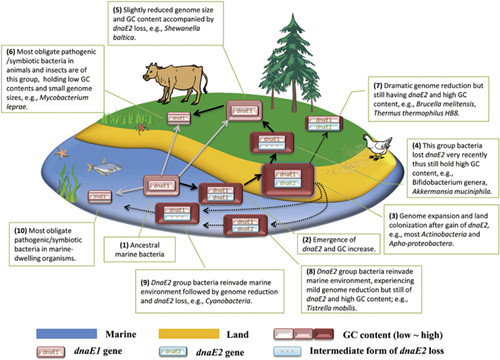Recently, a research team led by Prof. ZHANG Zhang and Prof. YU Jun at Beijing Institute of Genomics (BIG), Chinese Academy of Sciences (CAS), found that the emergence of DnaE2 gene contributed greatly to the success of bacterial land colonization. They also discussed the potential influence of various land-borne hosts (e.g., plants and animals) to early bacterial radiation. DnaE2 polymerase is a homolog of the main replicative polymerase DnaE1. It has been reported that this polymerase participates in error-prone repair instead of replication, resulting in bacterial GC content increase. DnaE2 polymerase is also found, in recently years, to be responsible for drug resistance in some bacteria, which raising great interests into researches of its 3D structure and detailed molecular mechanism. In this study, researchers provided a unified view of the contributions of DnaE2 to bacterial land colonization by combining taxonomic, phylogenetic and metagenomic analyses. They found that DnaE2-containing bacteria have similar taxonomic structure with that of soil-dwelling bacteria, at least at the phylum level. Further metagenomic data screening confirmed that DnaE2 is a soil-specific gene—DnaE2-containing bacteria tend to dwell in terrestrial environment, whereas non-DnaE2 group bacteria prefer to live in non-terrestrial environment, independent of their taxonomic position. They also found evidence indicating that DnaE2 may first appear in terrabacteria. All those evidence prompted them to hypothesize that dnaE2 is a background ‘hero’ who nailed the success of bacterial land colonization. A possible explanation is, that GC increase resulted from DnaE2 stimulated bacterial genome expansion and metabolic pathway diversification, which in return, increased the survival rate of bacteria when confronted with soil environment. This paper was published in the International Society for Microbial Ecology (ISME) Journal. The coauthors also include the first author Dr. WU Hao from BIG and Dr. FANG Yongjun from Ministry of Agriculture and Rubber Research Institute. This work was supported by CAS, Ministry of Science and Technology and Natural Science Foundation of China. A unified model of bacterial land colonization (Image by ZHANG Zhang's group) 
